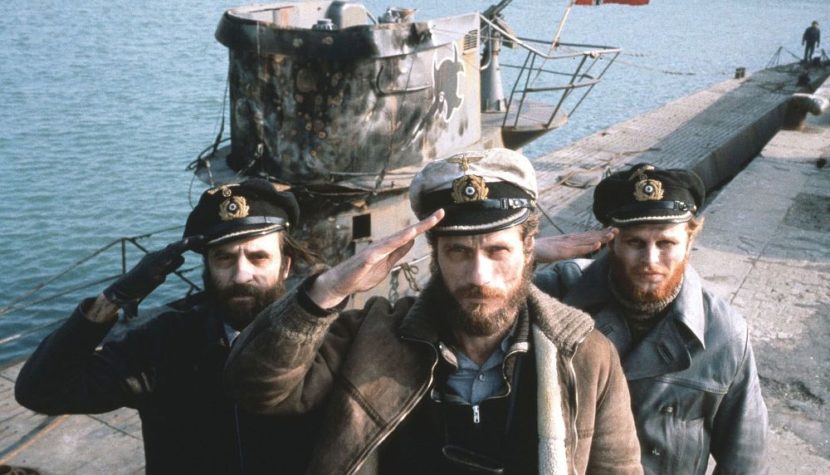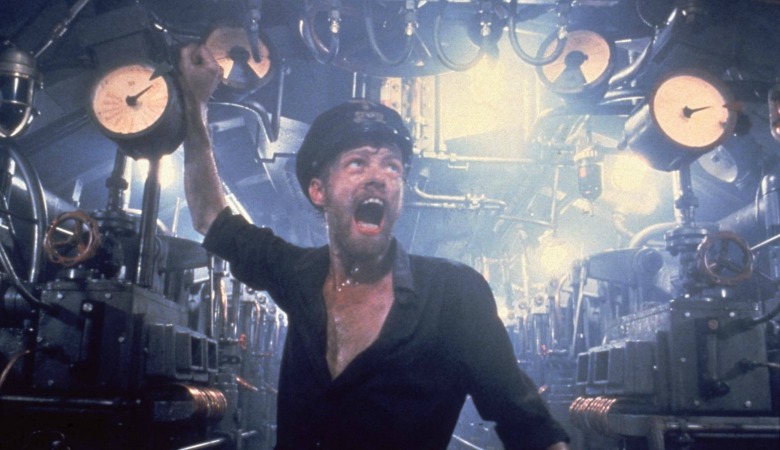DAS BOOT. Underwater Warfare

World War II shown on the big screen took many faces. There is no doubt, at least for me, that those of her faces that were able to perpetuate in the common consciousness were associated with broadly understood air and ground operations. In the flashing images, we saw battles fought in the ruins of cities, in the thick forests and on open beaches, with the graceful participation of tanks, artillery, napalm. We also saw the camp oppression of the Jews and all other forms of ideologically conditioned Nazi ruthlessness. The significance of these images was, and of course still is, unquestionable. However, they skillfully divert the viewer’s attention from the much less popular face of the otherwise same war – the actions fought in the sea space. And they were fought no less fiercely.
The most eminent cinematic presentation of the Second World War taking place at sea, and more precisely in its depths, is Wolfgang Petersen’s famous work entitled Das Boot from 1981. A work that, due to its uniqueness, I think, needs to be introduced to few people. There are few films that faithfully reflect the specificity of this particular type of war.
The film is an adaptation of Lothar-Günther Buchheim’s novel of the same name. It presents the fate of the crew of the German submarine U-96, which during the Second World War, in 1941 to be precise, patrolled the waters of the Atlantic Ocean for several weeks. The action boils down to showing the course of the U-boat mission, in which the essence are duels played with English Destroyers. However, Das Boot is not only focused on spectacularity, because in its nature it is more like a drama, focusing on human emotions and clearly manifesting an anti-war message.

The author of the book created its plot based on his own experiences. During World War II, he was a war correspondent. Thanks to this, you can feel that the story has a very believable background, rich in important details. In the intervals between successive duels, the viewer is occupied with the ship’s routine. In addition to organizing meals and moments of relaxation, sailors also feel homesick, and the claustrophobic atmosphere resulting from permanent confinement deepens the feeling of hopelessness. There are reflections typical of marine stories in which an individual functioning in a limited space (hermetically sealed in this case) is confronted with the vastness of the sea, and remains defenseless against its enormity and strength.
The feature that emerges when analyzing the portrait of the crew is the complete isolation of its members from the ideology of the Third Reich and undermining the authority of the supreme leader. Thanks to this, Das Boot has become one of those paintings that openly relativize the image of the German. A symbolic moment is the resounding on board of the song “It’s a Long Way to Tipperary” – a popular song of English soldiers – which can be treated as a blow to political blindness. But thanks to this, Petersen’s painting was criticized. The indignant veterans of the German Navy, refusing to show the image of sailors devoid of patriotism, published a book that corrected it with the telling title “Nein! So war das nicht” (“No! It wasn’t like that”).
But I am far from taking someone’s side, I am guided by my own thoughts, in which I consider war as a relative phenomenon. The division into good and bad is artificial, because during it, the opponents kill each other with equal ferocity and which side a soldier will be on does not depend on his conscious choice, but on his national affiliation. Of course, the precursor bears more responsibility for the bloodshed, but this rests with the highest authorities, not the gray militants, who often held in deep esteem what they would die for. What was important were honorable ideas and the implementation of the intended goals, not the kind of banner that flew over their heads. Das Boot is therefore not a film about “good Germans”, but about the fact that the motivation of many war maneuvers – whether from one or the other side of the conflict – could have had a much more pragmatic background. Suffice it to say that in the history of the activities of the German navy, only two cases of war crimes have been recorded – i.e. atrocities related to the violation of war rules established by relevant conventions. What conclusion follows from this, tell yourself.

Related:
The uniqueness of Das Boot speaks not only of the messages hidden in a solid plot, but also the fact that the film was excellent from the production side. As a result, the film was nominated for an Oscar not only for the screenplay (adapted), but also in such categories as: direction, cinematography, sound, editing and sound editing. Particularly noteworthy are the photos by Jost Vavano, characterized by daring camera travel through the ship’s narrow corridors. In the case of all the distinctions that fell on Petersen’s painting, however, the work done by Klaus Doldinger – the composer of the music – was omitted. There is no doubt that the famous musical theme is one of those elements of the film that can stand out from the rest and have a strong impact on the viewer. Later, this motif took on a life of its own. In the 1990s, a certain Alex Christensen, the creator of techno music, influenced by his fascination with Petersen’s painting, named the music band he founded U96 – in honor of the film ship. His most famous song – “Das Boot” – is just a spectacular reworking of the film’s main musical theme.
Das Boot also turned out to be a breakthrough film for people associated with its creation. For the German director Wolfgang Petersen, who has been working without much success in the field of domestic cinematography, the making of the film opened the door to a career in the West. Today, this name does not need to be introduced to anyone. He took advantage of his chance and made many exceptional films in Hollywood, usually characterized by a spectacular character. He even managed to return to the open sea twice thanks to The Perfect Storm and Poseidon. Critics agree, however, that none of his next films shot after Das Boot reached such a high level, thus the 1981 film is considered his magnum opus. Similarly to the work of Buchheim, who later wrote a continuation of his most important work, but it did not gain such publicity and, importantly, was not filmed.

After Das Boot, the career of the film’s leading actor, Jurgen Prochnow, also exploded. It is thanks to the international success of Petersen’s film that he has become one of the most popular and most frequently engaged actors of German descent in world productions. The fate of the actor Herbert Grönemeyer, who played the role of a war correspondent (that is, the character in which the author of the book’s original hid), was also interesting. Although he did not take up acting, he played in films occasionally, but he became a singer, valued and known not only in Germany.
Petersen’s work was released in several versions: the basic version (149 min), the director’s version (215 min) and the six-episode miniseries, which was re-edited years later and released in the “uncut” version (293 min). I assure you that whatever route you take to learn about the fate of the German U-96, it will be worth your attention and time. This is one of those war pictures, very peculiar, functioning somehow in isolation from the subject matter from which it originates. It’s hard to overestimate its value.





